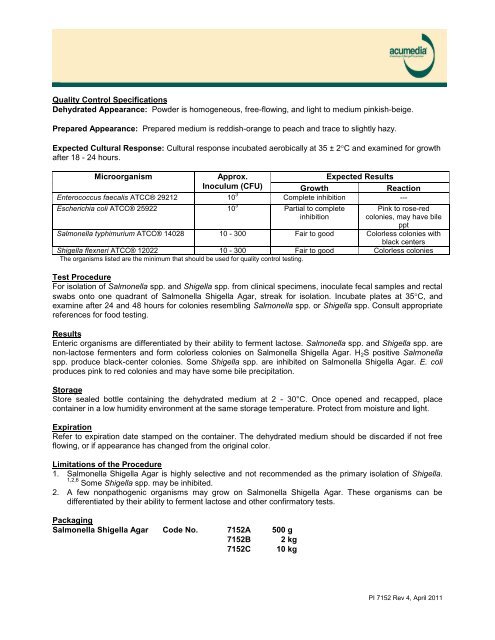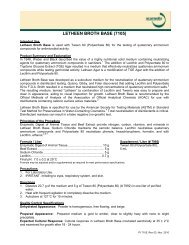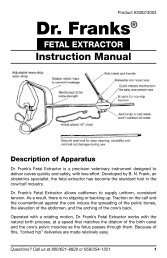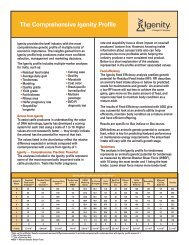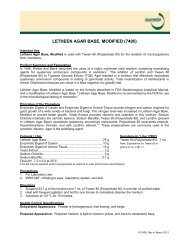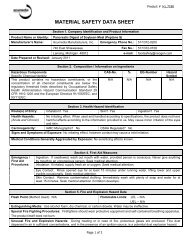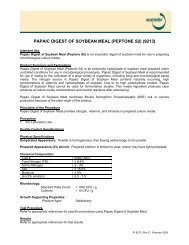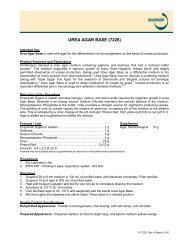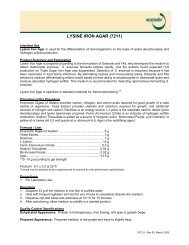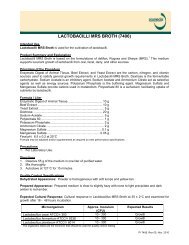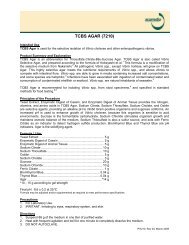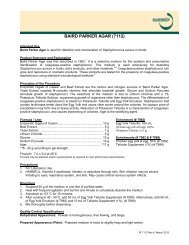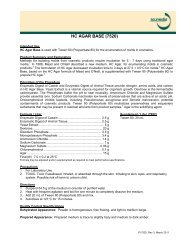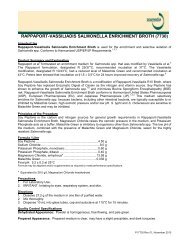Salmonella Shigella Agar Product Information Page
Salmonella Shigella Agar Product Information Page
Salmonella Shigella Agar Product Information Page
You also want an ePaper? Increase the reach of your titles
YUMPU automatically turns print PDFs into web optimized ePapers that Google loves.
Quality Control Specifications<br />
Dehydrated Appearance: Powder is homogeneous, free-flowing, and light to medium pinkish-beige.<br />
Prepared Appearance: Prepared medium is reddish-orange to peach and trace to slightly hazy.<br />
Expected Cultural Response: Cultural response incubated aerobically at 35 ± 2C and examined for growth<br />
after 18 - 24 hours.<br />
Microorganism Approx.<br />
Expected Results<br />
Inoculum (CFU) Growth Reaction<br />
Enterococcus faecalis ATCC® 29212 10 3 Complete inhibition ---<br />
Escherichia coli ATCC® 25922 10 3 Partial to complete<br />
inhibition<br />
Pink to rose-red<br />
colonies, may have bile<br />
ppt<br />
<strong>Salmonella</strong> typhimurium ATCC® 14028 10 - 300 Fair to good Colorless colonies with<br />
black centers<br />
<strong>Shigella</strong> flexneri ATCC® 12022 10 - 300 Fair to good Colorless colonies<br />
The organisms listed are the minimum that should be used for quality control testing.<br />
Test Procedure<br />
For isolation of <strong>Salmonella</strong> spp. and <strong>Shigella</strong> spp. from clinical specimens, inoculate fecal samples and rectal<br />
swabs onto one quadrant of <strong>Salmonella</strong> <strong>Shigella</strong> <strong>Agar</strong>, streak for isolation. Incubate plates at 35C, and<br />
examine after 24 and 48 hours for colonies resembling <strong>Salmonella</strong> spp. or <strong>Shigella</strong> spp. Consult appropriate<br />
references for food testing.<br />
Results<br />
Enteric organisms are differentiated by their ability to ferment lactose. <strong>Salmonella</strong> spp. and <strong>Shigella</strong> spp. are<br />
non-lactose fermenters and form colorless colonies on <strong>Salmonella</strong> <strong>Shigella</strong> <strong>Agar</strong>. H2S positive <strong>Salmonella</strong><br />
spp. produce black-center colonies. Some <strong>Shigella</strong> spp. are inhibited on <strong>Salmonella</strong> <strong>Shigella</strong> <strong>Agar</strong>. E. coli<br />
produces pink to red colonies and may have some bile precipitation.<br />
Storage<br />
Store sealed bottle containing the dehydrated medium at 2 - 30°C. Once opened and recapped, place<br />
container in a low humidity environment at the same storage temperature. Protect from moisture and light.<br />
Expiration<br />
Refer to expiration date stamped on the container. The dehydrated medium should be discarded if not free<br />
flowing, or if appearance has changed from the original color.<br />
Limitations of the Procedure<br />
1. <strong>Salmonella</strong> <strong>Shigella</strong> <strong>Agar</strong> is highly selective and not recommended as the primary isolation of <strong>Shigella</strong>.<br />
1,2,6 Some <strong>Shigella</strong> spp. may be inhibited.<br />
2. A few nonpathogenic organisms may grow on <strong>Salmonella</strong> <strong>Shigella</strong> <strong>Agar</strong>. These organisms can be<br />
differentiated by their ability to ferment lactose and other confirmatory tests.<br />
Packaging<br />
<strong>Salmonella</strong> <strong>Shigella</strong> <strong>Agar</strong> Code No. 7152A 500 g<br />
7152B 2 kg<br />
7152C 10 kg<br />
PI 7152 Rev 4, April 2011


